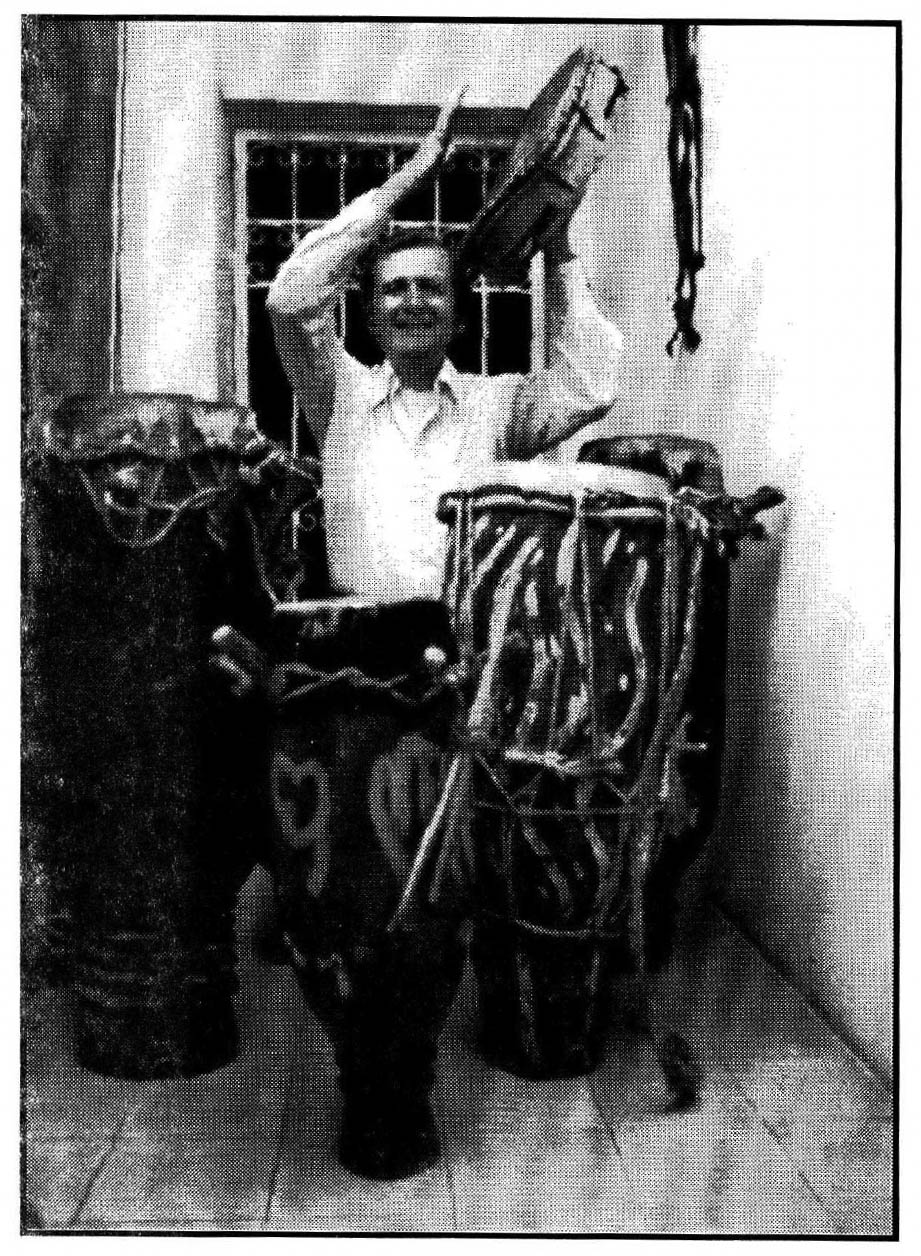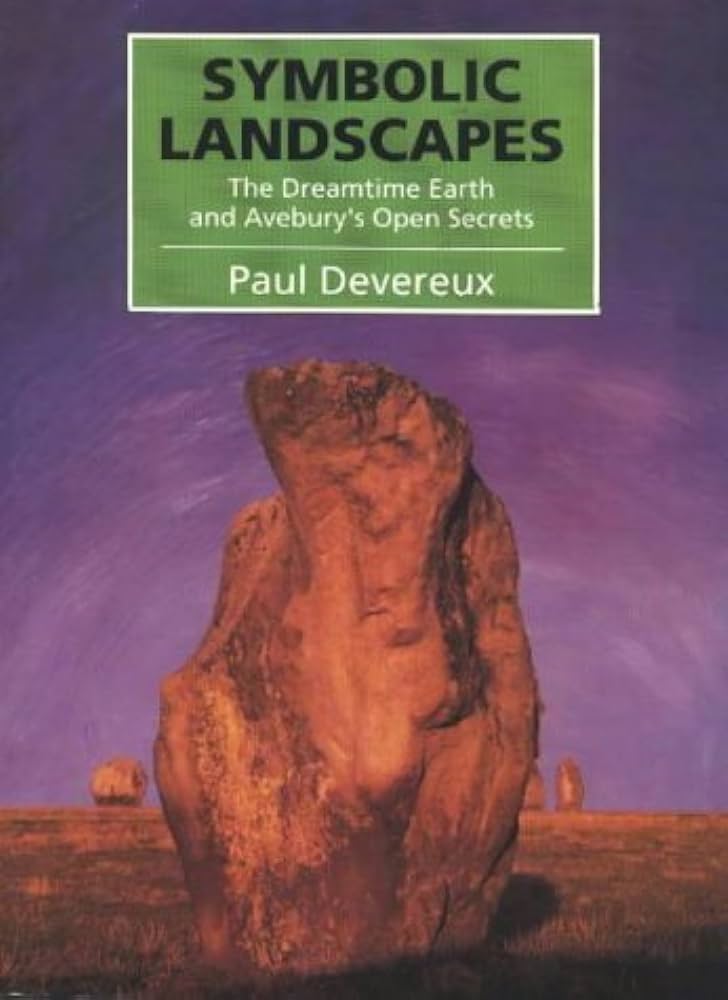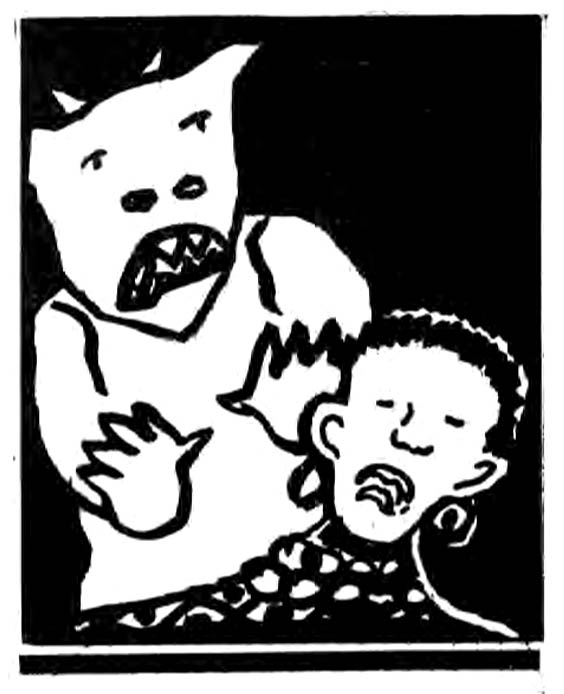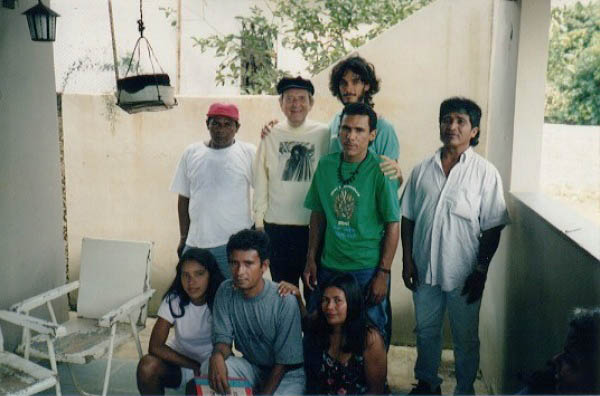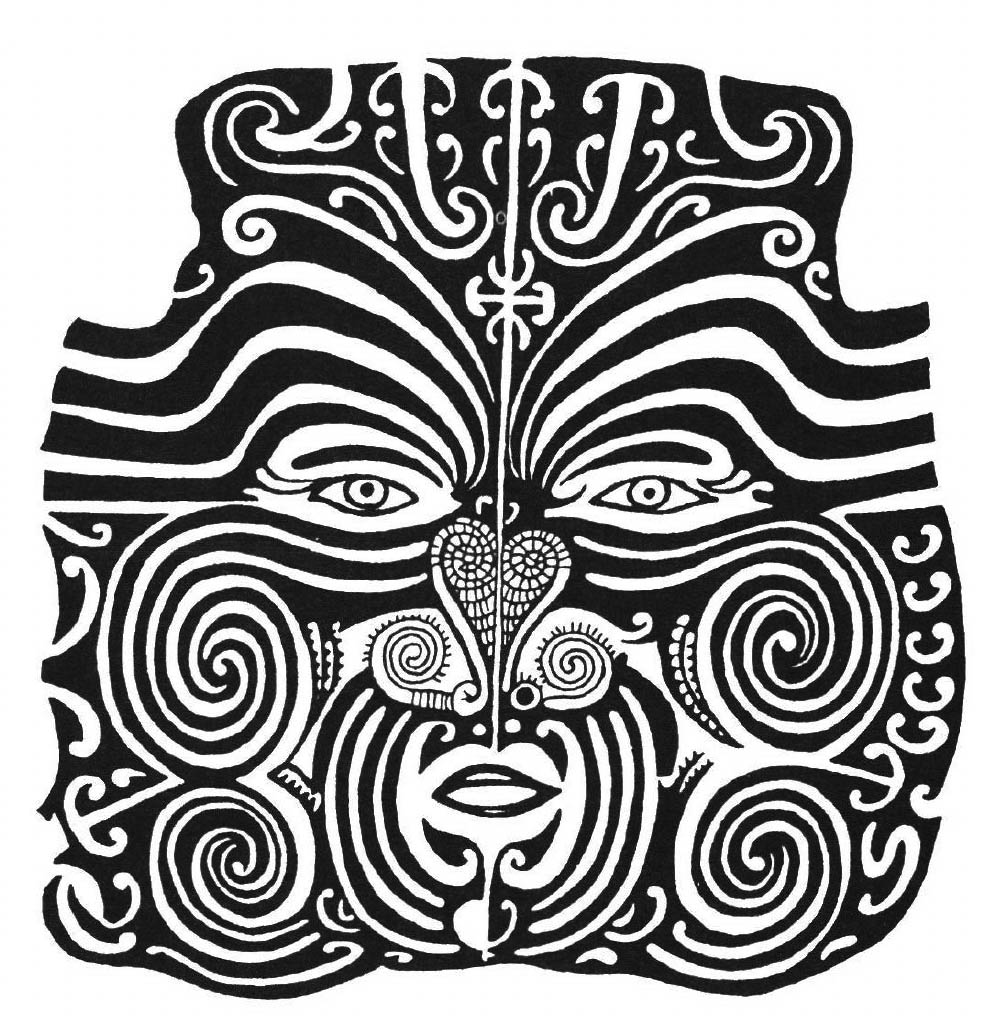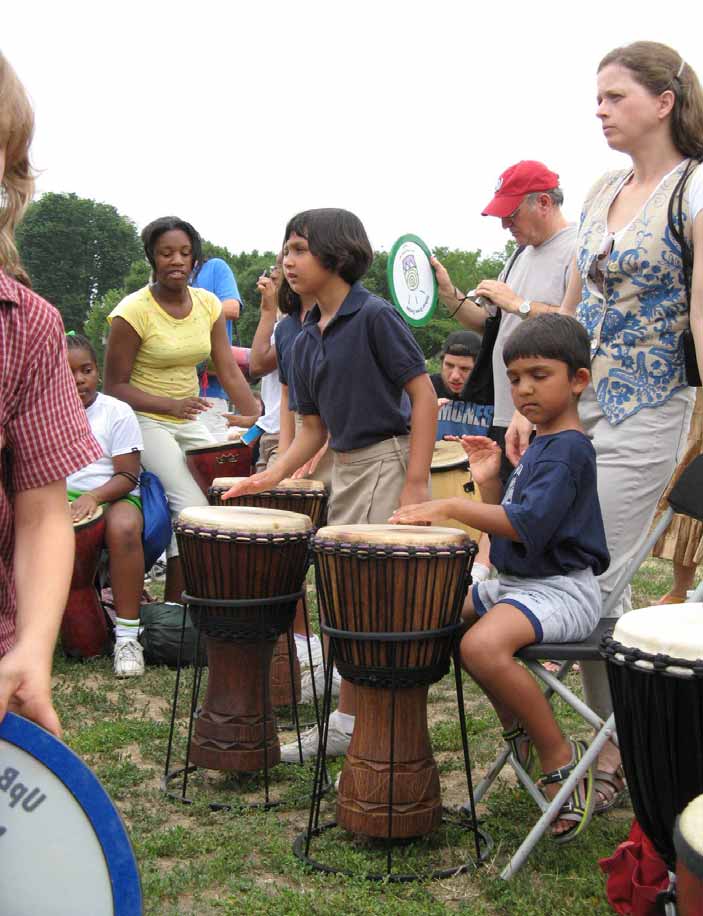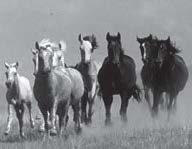by Stanley Krippner & Charles A. Winstead III
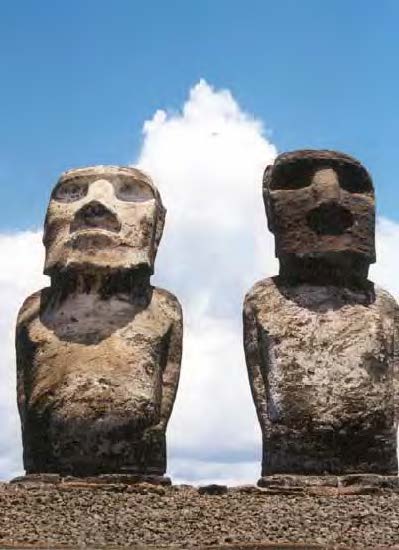
The puzzles of Easter Island's vanished civilization and its giant statues are unique in archaeology because of the isolation of this barren, volcanic land from its neighbors. Current archaeological evidence indicates that some 1,200 years ago the island's first settlers, explorers from Polynesia, found themselves in a pristine paradise with subtropical forests, dozens of bird species, and no predators. They prospered, multiplied, and distributed resources in a manner that suggests a sophisticated economy and a complex political system. Emulating the stone carvings of their Polynesian forebears, they began erecting ever-larger statues on platforms, as rival clans tried to surpass each other with displays of power and wealth. They had named the island “Rapa Nui” or “Big Island” apparently because it resembled “Rapa Iti” or “Little Island” elsewhere in Polynesia. Other traditional names for the island are “Te Pito o Te Henua” or “The Navel of the World” and “Mata Ki Te Rani” or “Eyes Looking at Heaven” (Gray, 2004; Van Auken, 2005).
But as the population soared, the forests were cut more rapidly than they were regenerating, and the once plentiful trees were transformed into fuel, canoes, houses, and devices for transporting the gigantic stone heads. Because there was no indigenous animal life, the growing populace consumed the local birds and insects as well as rats, descendants of those that had stowed away during the original settlement. The absence of wood for seagoing canoes reduced the fish catches; erosion and deforestation diminished crop yields. Disorder ensued; clan fought clan, toppling and desecrating each other's statues in the process. By the time the Dutch explorers arrived in 1772, the once-fertile island was barren and desolate. Its remaining inhabitants had degenerated into violence, starvation, and cannibalism (Diamond, 2005, chapter 2).
In December 2003, we had the opportunity to observe Easter Island first-hand, spending a week there and participating in five archeological tours. This essay attempts to convey our impressions of this remote island and discuss its mysteries, both those that have been solved by archeologists and histories, and those that remain enigmas.
Two Legendary Dreams
Easter Island is referred to by many names. In Spanish it is called Isla De Pascua, referring to the arrival on Easter Sunday by Dutch explorers. However, it is likely that at least one Spanish expedition passed by the island in the late 16th century, and that the English buccaneer Edward Davis landed there in 1687 (Flenley & Bahn, 2002, pp. 1-2). The Spanish claim is supported by the presence of Basque genes among current inhabitants; however, lusty whalers could have donated these genes during the 19th century because Basques were often members of these commercial voyages (p. 2). The English claim is a weak one since Davis' journal does not mention the stone monoliths that would have been strikingly visible at that time.
Captain Cook paid a brief visit to Easter Island in 1774; a Tahitian native accompanied him and was able to converse with the islanders, telling Cook about their Polynesian origins. DNA testing later verified this assertion, linking the islanders to the Marquesas or Society Islands (Flenley & Bahn, 2002, p. 9) or to Mangareva, Pitcairn, or Henderson (Diamond, 2005, p. 88). John Flenley and Paul Bahn (2002) underline how unlikely it was that Rapa Nui "was found even once, and how incredibly unlikely it is that it maintained contacts with the outside world" (p. 74). Easter Island is the most remote habitable place in the world; the nearest land masses are Chile, 2,300 miles to the east, and Pitcairn Island, 1,300 miles to the west. Its initial discovery remains a mystery shrouded in legend and oral tradition, although Jared Diamond (2005) has noted that Polynesians knew how to anticipate an island (e.g., observing flocks of seabirds) long before land became visible (p. 88). Hence the discovery of Rapa Nui may have been premeditated rather than accidental.
The word Rapa Nui does duty as the name for the language, the island, and the people of the island (Fuentes, 1960). Legend has it that Hotu A Matu’a (translated as "The Great Parent"), a Polynesian monarch from the land of Hiva, had a dream of a large (nui) island (rapa) that would be suitable for settling. This event is said to have occurred around the 4th century C.E., when Hotu sent a group of seven sailors on a mission to locate that island. They were successful, and Hotu decided that his extended family should move to this island. Radiocarbon dating of reeds thought to have come from an ancient grave placed this settlement as early as 318 C.E. (Gray, 2004), but later data indicate that the reeds were not associated with human activity and that a date no earlier than 900 C.E., based on wood charcoal, was proposed (Diamond, 2005, p. 89). More recently, radiocarbon data discount the 900 C.E. date and imply that the island was populated even later, about 1200 C.E. (Hunt & Lipo, 2006).
A reliable chronology is essential for the understanding of the cultural, ecological, and demographic processes involved in the rise and fall of this civilization. Major time and energy was invested in the monumental architecture that appears to have been constructed shortly after colonization. Therefore, that is why tracing this isolated civilization—that once flourished but suffered ecological catastrophe— is an important endeavor. Earlier Polynesian colonizations on Fiji, Tonga, and Samoa date back some 2,800 years, but did not expand into Cooks, Societies, Marquesas, and Hawaii until about 800 C.E. New Zealand was settled at about the same time that settlers arrived in Rapa Nui. These dates have been confirmed by radiocarbon dating of seeds gnawed by the Polynesia rat, a species commensal with humans (Hunt & Lipo, 2006). In addition, Hunt and Lipo (2006) excavated 12 distinct strata, finding that the bottom stratum of clay was entirely devoid of cultural materials, confirming a 1222 C.E. date for the initial human occupation. These data seem persuasive but some dissenters still hold out for an earlier date (Gibbons, 2006).
Whatever the date of settlement, there are legendary accounts that Hotu A Matu’a and his community sailed to the new land in two ships, one of his own and one of his sister, Ave Rei Pua. According to tradition, these canoes not only carried at least 100 people but also provisions (such as potable water), domesticated poultry, animals (pigs and dogs that later became extinct), seed stocks, cuttings, whole plants, and other items deemed necessary for the new settlement. Today, the legendary seven sailors are memorialized on a hillside far from the coast at a location known as Ahu Akivi (Rapa Nui, 2003).
The early legends and traditions, known as Pua Aroa Hoa, were compiled in a Rapa Nui manuscript, written at the beginning of the 20th century. This document tells the history of Hotu A Matu’a in detail, as well as the circumstances that motivated his departure from Hiva, his ancestral land. During the reign of Hotu’s father, King Ariki Matu’a, the kingdom's seers (maori) foretold that one day the earth would rise, leaving disaster in its wake. Therefore, following generations were told to construct canoes to be ready to escape at any time. There was another well-known tale concerning the dream of Haumaka, a Polynesian spirit, who looked to the east for a new land. On arriving at the land, the dreaming spirit descended over the islets in the southwest corner of the main island, now known as Motu Kao Kao, Motu Iti, and Motu Nui. The spirit ran through the island over the southern coast up to the bay, currently known as Anakena. Hotu decided to forestall disaster by finding the location in Haumaka's dream, a place where he and his people could live in safety (Rapa Nui, 2003).
On occasion, the spirit returned and possessed the sleeping body of Haumaka, who again consulted with the original king, Hotu A Matu’a. Being privy to these consultations, the seers passed on the information to Hotu's successors who used the reports as a guide for decision making and public policy. However, the Pua Aroa Hoa account does not answer a crucial question posed by Jacob Roggeveen, the early Dutch sea captain. Noting that the islanders' watercrafts were "small and leaky canoes" (Diamond, 2005, p. 81) capable of holding only one or two people, how could the 100 or more Polynesian colonists have safely brought their crops, poultry, and drinking water on a two or three week journey from their native land?
Attempts to answer this question were made by Thor Heyerdahl (1958) who speculated that the navigators came from Chile, and by Erich von Daniken (1969) who claimed that the stone monuments were erected by stranded aliens from outer space before their rescue. Neither author's claims faced what Diamond called "overwhelming evidence" that Easter Island's culture and language grew out of Polynesian antecedents, that the culture's sole domestic animal, the chicken, was typically Polynesian and that the unearthed skulls exhibit specifically Polynesian features (p. 86). Hence, it is more parsimonious to conjecture that over the centuries Easter Islanders lost the canoe-building skills of their progenitors because they had no need or desire for extensive sea travel.
Social and Spiritual Hierarchies
At its peak, Easter Island might have been home to 30,000 people (Diamond, 2004, p. 90) who lived in a dozen subdivisions integrated under the leadership of one paramount chief. Considerable archeological evidence indicates that these clan territories worked well together, trading basalt, fish, and other localized resources. From the legendary reign of King Hotu A Matu’a onward, a social order became well defined. It included the royal family (aria pack), the religious aristocracy (consisting of seers or maori and priests or ii at), and military chiefs (matatoa). Further down in the hierarchy were the teachers (maori Rongo Rongo, whose major duty was teaching the art of reading the script by the same name), and the commoners (huru manu) who fell at the bottom of the social pyramid (Rapa Nui, 2003).
The position of the aristocracy was sustained on divine origin as descendants of the creator gods. The Ariki’s lineage from Rapa Nui established that the first born son was to be given the power of the religious leader, or major priest, of the island. Important men such as the Ariki purportedly were endowed with special spiritual powers called varua, and protected by the traditional rules or tapu.
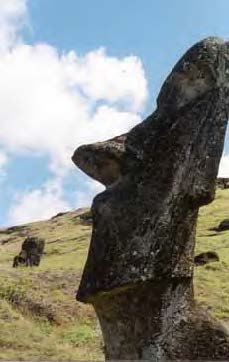
Another hierarchy was composed of spiritual entities. Make Make, the creator god, was omnipresent; and brought varua into the world. At the second level fell the forces of nature, or Aku Aku, including the ocean, storms, sharks, and other agencies. One description of Aku Aku places it in the center of the earth, especially in volcanic lava. It is asleep but upon awakening, it would voraciously consume the earth. Hence, specific rituals are required to keep Aku Aku tranquil. This description of Aku Aku describes it as neither male nor female, neither good nor evil. The human counterpart of Aku Aku resides in the blood, and similar requirements are needed to avoid its awakening and the ensuing disasters. An alternative description holds that Aku Aku is omnipresent, as is the deity Make Make. However, in this form Aku Aku is a malignant counterpart to the positive energy of Make Make.
The third level of the spiritual hierarchy is composed of ancestral spirits who are able to intervene with the spirit world on behalf of the living. When people die, their varua or spirit energy continues to exist. Edifices referred to as moia probably were constructed to provide a receptacle for the varua. Once an ancestor was housed in a moia, he or she could continue to provide support for the living.
The fourth spiritual level is everyday varua, which is present in all things, ranging from light to living people. One type of everyday varua is the varua mai tai, a dream spirit who is able to walk in the world even during the day. Another type is varua moi, a special type of oil used in a lamp as well as a special grease prepared from animal fat or sweet potatoes and used for lubrication.
The “Birdman Cult” was a late development. In springtime, aspiring tribal leaders sent representatives to sequester themselves in a ceremonial cave until the day when they would leap off the cliffs and swim to nearby islets. The first to return with the egg of the sooty tern, a white bird with long, narrow wings with black fringes, was announced Birdman Chief, but only for one year. The ceremony was threatened during the civil wars of the 1600s, when clan rivalry destroyed many statues and traditions. However, the cult survived until the 1860s, and Birdman petroglyphs are still visible (Flenley & Bahn, 2001, pp. 175-177).
The term varua is used not only to describe spiritual energy but spiritual practices, such as conversing with spirits. An oral tradition is used to teach children the chants that are used to contact the spirits of ancestors. These chants utilize the ancient Rongo Rongo language, the language supposedly depicted on stone tablets. However, the connection between the chants and the writing has been lost. Spirits are contacted for various purposes, such as protection against earthly enemies and malignant spirits, providing advice to treat injuries and illnesses (such as what plant to use for medicinal purposes), and to assist in conflict resolution and provide for survival during times of natural disasters.
Dreams are considered to be an important vehicle for communication between humans and the spiritual world, and moe varua is a term used to describe dream interpretation. For example, if someone dreams that an acquaintance or family member is sleeping, it is believed that death will follow. Dreams are considered to be part of the spirit world. In this world, spirits do not always take human form; they can be animals or even inanimate objects.
Young members of a clan go to an elder to learn about the spiritual practices that involve varua of different types. This connection with the elder often continues past the elder's death because the special abilities of the elder result from the knowledge and ability to control and channel varua. The moai structures were constructed not only to provide a sanctuary or receptacle for the varua of deceased elders but also to provide a locus for the entreaties of living persons who wish to communicate with those deceased elders. The completed statue would represent the elder’s vivid face (aringa ora), and would project varua over the land and those who lived on it. The development of these stone structures is yet another example of how this connection with deceased rulers and other elders developed over time and produced spectacular visible results (Mena, 2002; Van Tillburg, 2004).
The Statues
The most impressive feat of the Easter Islanders’ Stone Age culture is the production of some 838 gigantic stone statues, the moai, and the placement of several of them on platforms or altars, the ahu. They were apparently created between the 10th and 17th centuries, and show a clear evolution in size and style (Mena, 2002). The outside world’s first recorded mention of the moai appears in the journal of Cornelius Bowman, one of Roggeveen’s captains. On April 8, 1722, Bowman wrote, “On land we saw several high statues in the heathen fashion” (Flenley & Bahn, 1002, p. 106). The Spaniards who apparently sailed by Rapa Nui in 1770 seemed to have mistaken the statues for huge shrubs. Captain Cook’s party heard the term ariki applied to some of the statues, and later explorers noted that islanders often used nicknames for them (e.g., “Twisted Neck”, “Tattooed One”, “Stinker”) (p. 109).
The American author Herman Melville (1917), in Typee, relates how he came upon a huge wooden statue with staring eyes, standing on a stone platform. The mutineers of the ship Bounty found large stone images standing on shrines in Pitcairn Island; unfortunately, they threw them off a cliff (Flenley & Bahn, 2003, pp.103-104).
The Polynesian origin of Rapa Nui partially explains the motivation behind the statues’ creation; the carving of huge human figures in igneous rock to honor (and sometimes to bury) royalty was fairly common in Polynesia. For example, in the Marquesas there are large statues of rotund men placed on ceremonial platforms similar to the ahu in Rapa Nui. The statues not only memorialized departed nobility, but were believed to serve a protective function for the living. Rapa Nui rises some 10,000 feet up from the floor of the Pacific Ocean; it has no natural reefs to protect its shores from tidal waves. No two of the statues are identical; dozens of them contain detailed designs in bas-relief on their backs that may signify signs of rank. Between the fingertips and below the navel of a typical moai is a feature believed to be a hami, the fold of a loincloth. Occasional lines that curve across the small of the back are thought to represent the maro, the sacred loincloth of authority. The maro was important in denoting the ranks of both chiefs and priests throughout Polynesia (p. 205).
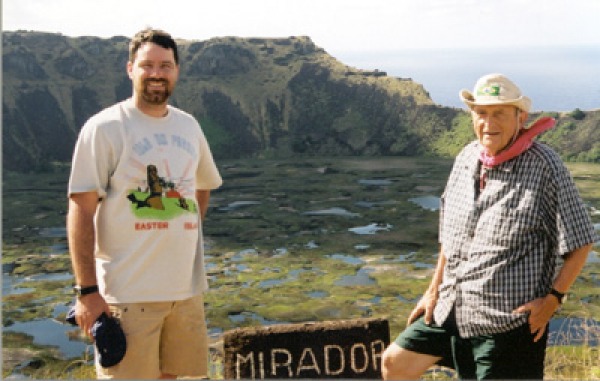
Although the average moai was between 13 and 14 feet tall and weighed about 10 tons, “El Gigante”, arguably the largest statue ever created, is over 68 feet in length and weighs some 270 tons. Lying unfinished in a quarry, it is one of Easter Island’s enigmas. Was it commissioned by an egocentric ruler? Was it abandoned once the workers realized that it could not be raised or moved? Perhaps it was never intended to be a standing statue, but simply a colossal petroglyph or funerary statue. Or it may have been abandoned as part of the general cessation of statue building that occurred during Rapa Nui’s decline (Mena, 2002; Flenley & Bahn, 2002, p. 105).
A moai that is 32 feet in length was moved onboard a ship by British sailors in 1868 and taken to an archeological museum in London. When it left the island, the natives referred to it as hoa haka nana, “the stolen friend”. Later, carved blocks (paenga) from an ahu were used for the construction of water tanks (Mena, 2002). However, natives themselves had used stones from these platforms to construct garden walks (manavai) and burial chambers, the latter being required once traditional cremation was no longer possible due to the lack of wood (Diamond, 2005, p. 110).
The earliest moai were fairly small, naturalistic in style, and represented only the head. These heads were more round and less detailed than later constructions. The heads were placed atop the sarcophagal platforms constructed between the villages and the sea, facing the village. As time passed, the heads became more stylized, taller, and more elaborate incorporating the arms, the torso, and the hands at their base. Later, a new style was developed incorporating red topknots (pukao) that probably represented hair or possibly feathered hats or crowns. One pukao is 6 feet in diameter and weighs 11.5 tons; lifting it to the top of its moai would have been an engineering challenge. Not only is the process of raising the statues onto their platforms poorly understood, but the placement of the pukao remains “a truly awesome and prestigious feat of engineering” (Flenley & Bahn, 2001, p. 145).
Eyeballs were made from a variety of substances including coral, and the pupils often were made from obsidian or other stones. The latter moai were much taller, had leaner torsos, and slimmer heads. They had more elongated facial features and higher foreheads to support the topknots. Few examples of the coral eyeballs have been found, leading some writers to suggest that the sockets were meant to remain empty, at least during one stage of the construction process.
Flenley and Bahn (2001) wrote that “it is virtually certain that the statues represented high-ranking ancestors, often serve as their funerary monument, and kept their memory alive” (p. 109). They speculate that eyes were left uncarved while the ancestor was still alive; only after death were the sockets hollowed out, the statue moved to its platform, and its eyes and sometime a headdress put in place, perhaps to activate the statue’s varua or spiritual power.
There was always danger from salt spray damaging the crops or tidal waves endangering villages; however, the figures were erected facing the villages rather than the ocean (pp. 109-110). Because the gender of the statues is ambiguous, some writers have speculated that the nose was deliberately or unconsciously shaped as a symbolic phallus, while the protruding thin lips with a groove between them was carved in the form of a vagina (p. 110).
Most of the moai were carved from a soft yellow-brown pyroclastic rock formed when lava was ejected into the air. This rock is known as lapilli tuff or Rano Ruraku tuff, because half the statues have been found in that volcanic quarry known as Rano Ruraku (named after an ancestral spirit). The statues made from Rano Ruraku tuff were all erected on platforms. These statues are larger than the 55 or so moai made from other stone such as red or gray scoria, basalt, and trachyte, the latter a dense white stone. Instead of metal, pillory and basalt adzes (toki) as well as those made from even harder stones were used for carving; the finished product was polished with pumice and similar materials.
The quarry of Rano Ruraku, the origin of over 90% of the island’s moai, is one of the world’s most extraordinary archeological sites. Diamond (2002) has written, “No other site that I have visited made such a ghostly impression on me” (p. 80). Flenley and Bahn (2001) have suggested that a number of fairly independent groups from different parts of the island carved the moai rather than being under the domination of a central power. This may have been a competitive effort, and may explain, at least in part, the high number of unfinished maoi in Rano Ruraku and on other parts of the island.
Perhaps because of competition, perhaps out of boredom, perhaps out of devotion, prehistoric people (in Western Europe as well as on Rapa Nui) spent vast amounts of time and toil carving, transporting, and erecting the huge stones. Heyerdahl (1958) hired six met to use local picks to carve the outline of a 15-foot statue. It took them three days, and it was estimated that it would have taken at about one year for a team of 20 men, working daily, to complete a statue.
Flenley and Bahn (2001) concluded, “What is certain is that specialized master-craftsmen were at work here; the islanders reported that the sculptors had been a privileged class, their craft being hereditary in the male line, and that it was a matter of great pride to be a member of a sculptor’s family” (p. 116). The figures were carved on their backs, with the base usually pointing down-slope. Early maoi heads are rounder, wider, and have low foreheads. As this practice evolved, statues grew to include the torso down to the waist. Arms are depicted coming down the sides, fingers meeting just below the navel. As time passes, the figures become taller and leaner, and the faces become more angular. The red stone pukhao was introduced in the later period of statue building and this feature required higher and more substantial forehead designs.
The stone altars or platforms (ahu) were made from rubble held in place by four basalt restraining walls, holding up to 15 moa per ahu. They resemble similar structures in eastern Polynesia, reinforcing the opinion of most writers regarding the origin of the islanders. However, the ahu are not the only type of stone structure on Rapa Nui. The following list is organized more or less chronologically according to when the various structures are thought to have appeared, according to our local guides.
Hare moa, a stone structure used to house chickens.
Manavai, stone enclosures and pathways to protect crops.
Hare paenga, foundations for a simple shelter. This style of construction, still abundantly in use, resulted when arriving settlers turned their canoes upside down for shelter (Mena, 2002). Stacks of rock around the perimeter form walls.
Cave houses resulted when the mouths of caves were closed off with walls. Later, these enclosures were expanded, forming three walls of additional rooms. The mouth of the cave was part of the fourth wall.
Free-standing dwellings were constructed in a manner similar to the expanded enclosures in front of the cave houses, although the cave is not present and the construction forms all four walls.
We visited one cave used as an early burial site and a pit used as a crematorium. The outdoor sarcophagi resembled homes of the free-standing type, but were filled in with rock rubble; archeologists refer to them as Ahu Sarcophagi. However, burial seemed to have been the exception rather than the rule in Rapa Nui, because no early skeletons have been found. However, cremation was not a typical practice in eastern and central Polynesia (Flenley & Bahn. 2001, p. 136). At some point, stone carvings representing the deceased ancestor were placed atop the Ahu Sarcophagi. In the earliest days of this practice, moai were short and depicted the head only. At Ahu Akivi, a site restored in 1960, there are gravesites directly behind the statues. At other sites, the sites were placed between the village and the shoreline. Some are quite close to the shore suggesting that the island ran out of room for burial sites. Cremation was not a typical practice in eastern and central Polynesia (Flenley & Bahn. 2001, p. 136), but the scarcity of land may have demanded it in Rapa Nui.
Later, semi-pyramidal ahu were constructed composed of several layers of stacked finely worked stone blocks, lifting the moai up two to three meters off the ground at their base. Thor Heyerdahl interpreted this stone work as suggesting that the people of Rapa Nui emigrated from South America and were influenced by Incan style of stone work. However, the dates of the two pieces of work do not coincide and the Rapa Nui style of stone work is substantially different. Incan pyramids are of solid construction throughout, whereas the semi-pyramidal ahu are filled with rubble.
Earlier moai had shorter heads and short ears and later moai had larger heads and long ears, leading Heyerdahl (1950) to misinterpret the name of the two primary clans as “short ears” and “long ears”, or “thin people” and “fat people”. Heyerdahl speculated that these were the two groups, perhaps representing two different waves of migration, who fought battles and toppled the moai. He surmised that the battles destroyed a large amount of the island’s natural resources; it is more likely that the ruined ecology triggered the civil wars rather than resulting from them. In addition, it is plausible that these differences in the moai represent an evolution reflecting changing tastes, purposes, and shifting placements of the moai.
How Were the Statues Moved?
The Rapa Nui culture was a Stone Age culture; the wheel was unknown as was the manufacture of metal tools. This was, however, the only Polynesian culture known to have developed a script, the Rongo Rongo, which was engraved on wooden boards. In addition to their skills in navigation, the Easter Islanders were talented engineers, as is evident when one inspects the moai and the ahu. Heyerdahl (1958) famously mimicked the engineers of Rapa Nui, “Guess how this engineering work was done! Guess how we moved those gigantic figures down the steep walls of the volcano and carried them over the hills to any place on the island we liked!”
In 1722, the Dutch explorer Roggeveen was misled by the color of the tuff and its composite nature, concluding that the statues were molded in situ from a mixture of clay and stones; some of Cook’s officers came to the same conclusion in 1774. When the islanders were asked how the statues were moved, they responded that they walked a short distance each day until they reached their platforms. Before ridiculing this explanation as the conjecture of “primitive minds”, one should read the contemporary account of Erich van Daniken (1969) who attributed the construction of the statues as well as their placement to stranded extraterrestrials!
Most archeologists take more parsimonious approaches, noting that the transportation was not necessarily the weight of the moai but their fragility; Rona Raraku tuff is not extremely solid or dense, and it was important not to damage the images that had already been carved on the figures. Hundreds of statues had been moved from the quarry, some of the smaller ones more than six miles (Flenley & Bahn, 2001, p. 122).
In 1934, a team from Belgium and France moved a six ton statue with a sledge pulled by 100 islanders. Heyerdahl’s team moved a ten ton statue with a sledge pulled by some 180 islanders using two parallel ropes. Another oral tradition holds that, rather than self-initiated walking, the statues were pulled by men using lubricants made from mashed sweet potatoes and yams. The current conjectures can be summarized:
Dragging. This version is the currently favored academic explanation, and one variety adds poles or beams that were used as leverage. The moai are hypothesized to have been lifted and tilted forward. A Czech engineer worked with a nine ton replica of a moai, placing it on a sledge; 30 men were unable to move it. Using sweet potatoes paste made the pulling easier, but when the sledge was placed on beams, only ten men were needed to pull it. Other successful attempts have used rollers and slides (Flenley & Bahn, 2001, pp. 122-126). However, these endeavors were made on surfaces smoother than the Rapa Nui pathways. Diamond’s (2005, p. 100) suggestion that modified “canoe ladders” were the transport vehicles accords with dragging devices elsewhere in the Pacific. Oral traditions hold that, once transported, the moai were erected with ramps of stones, levered by logs (p. 101).
Walking. This supposition holds that the statues were propped upright, tilted from side to side, and then shuffled forward. This conjecture may have originated in the legends that that the statues “walked” to their locations. The original objection to this scenario of upright transportation was that swiveling damages the base of the statue, and that the friction would soon have worn the soft tuff down to the statue’s nostrils. However, an American geologist worked around this problem by placing a replica statue upright on two green logs carved into sledge runners, and then raised it onto a track of small wooden rollers. He was able to move the statue nearly 150 feet in two minutes using 25 men and two ropes (Flenley & Bahn, 2001, pp. 127). This method causes no damage to the base and would be feasible even on hilly terrain. However, it presupposes the presence of material for rope construction, an assumption that is open to question given current knowledge of the tree bark available at the time (p. 129).
Carrying. Recent excavations and examinations of the moai roads suggest a more complication explanation to some writers (Mena, 2002). It has been posited that vertical posts were placed over the two sides of specially prepared pathways and the statues were carried with ropes and levers. Some were carried to the sea, where boats transported them to their eventual sites; indeed, a large number of completed moai are close to the water’s edge. However, this placement was to be expected if the statues’ function was one of protection; further, the rope, lever, and post explanation assumes a plentiful supply of rope material, a debatable conjecture (as stated earlier).
Varua. Rather than attributing the feat to extraterrestrials, a few writers (e.g., Gray, 2004; Van Auken, 2005) have put forward the idea that some type of anomalous energy was used to move the moai to their positions. One version of this position has the statues being moved to rafts by varua, then taken to their approximate location and lifted into place with varua again. The tangential “evidence” for this feat is said to include a “road” near one of the ahu that leads into the water. Although eccentric, this explanation has the virtue of attributing varua to indigenous people rather than to extraterrestrials; von Daniken’s conjecture belittles the abilities and ingenuity of indigenous people in favor of a “superior” species from outer space. Flenley and Bahn (2001) have taken one element of this proposal seriously; they have suggested that some figures might have been transported the short distance from the quarry to the shore and then floated on timbers or rafts around the coast to their platforms. Fragments of Rano Ruraku tuff on a platform-like structure have been found on an offshore island (p. 132).
It is likely that no single explanation will suffice for all the moai; different techniques may have been used for various sizes and styles of the statues. Because the roadbed surfaces were, in all likelihood, too rough to easily accommodate dragging, skidding, or tilting, as well as sledges, rollers, or slides. Flenley and Bahn conclude that “the mystery of statue transportation remains intact” (p. 133).

Why Were the Statues Toppled?
Most of the moai were still standing in 1774 when Captain Cook visited Rapa Nui. However, some fighting was observed and several statues had already been toppled. By the next European visit in 1840, all of the moai had been toppled. If Captain Cook had stayed longer than the few days he spent on the island, there would probably have been no unsolved mysteries of Easter Island. Cook was a keen observer and recorded his observations with meticulous accuracy. Flenley and Bahn (2001) have noted that Cook “would probably have discovered the religious significance of the giant statues, the history of their downfall, and the meaning of the Rongo Rongo” (p. 149).
The toppling of the statues was no easy task, and probably involved ropes, levers, and numerous men working together. The tallest and heaviest maoi ever erected on an ahu was the last to be overthrow, its huge pukao coming to rest only a few feet from it. Many of the statues were beheaded, preventing them from being erected again. Most were toppled landward, perhaps to cover their eyes. In one case, a statue resting on its back had its eyes completely pulverized. It was as if deliberate efforts had been taken to extinguish the varua associated with the huge megaliths, rendering them impotent.
Many writers have concluded that inter-clan fighting was the cause of the statue toppling. In the late prehistoric period of Rapa Nui, there was the sudden appearance of weapons made of obsidian, a material previously used only for tools. It has been suggested that as the population soared, the forests were cut more rapidly than they were regenerating and trees were transformed into fuel, canoes, houses, and rollers and ropes for transporting the gigantic stone heads. The growing populace consumed the local bird and animal populations; the absence of wood for seagoing canoes reduced the fish catches; erosion and deforestation diminished crop yields. Disorder ensued; clan fought clan, toppling and desecrating each other's statues in the process (Diamond, 1995).
A legend regarding the start of the war has to do with a cultural misunderstanding between clans. In one clan, hospitality required special treatment of guests. An old man with only one son was visited by members of another clan. He prepared a special meal of chicken intestines for his guests. The story goes that they were disgusted by what had been presented to them and jokingly refused by stating that they did not eat chicken intestines, rather they only ate human intestines. The old man was bound by traditions of hospitality and killed his only son and prepared the child’s intestines for his guests. When the guests saw what the old man had done, they ran away. Realizing that he had been lied to, the old man went to his people and they went to war seeking revenge. Because of the shortage of resources, this was a war “waiting to happen”, and the legendary incident—or one like it— triggered the ensuing bloodshed.
Environmental Degradation
Easter Island provides a model of human-induced environmental degradation (Hunt & Lipo, 2006). Diamond (2002) called it ‘the most extreme example of forest destruction in the Pacific” (p. 107). The fate of the environment on Easter Island has risen and fallen with the history of the people who have lived there. When the first Polynesian explorers arrived, the island would barely support human life. The colonizers brought food crops and animals with them and relied primarily on fish for protein. The founding population grew rapidly; this growth had immediate visible impacts on the island’s ecology. The huge monuments may have represented cultural investments that mediated against the impact of the rising population, such as resource shortfalls (p. 1606). The population may have reached a peak of about 30,000, but shortly after the Europeans arrived, it was reduced to a few hundred people by local wars, Old World diseases, and the European slave trade. The population currently stands at around 3,500.
How could the island’s ecology been devastated so completely? Some archaeologists think that adverse storms and changes in the climate occurred. However, it is more likely that indigenous palm trees were cut down for islander use and that the forests were wiped out as a result of the statue building and transporting crazes (Gibbons, 2006). If so, the reduction in forests probably occurred slowly and would have been difficult to detect immediately. One islander might easily have missed the trend, saying, "This year we cleared those woods over there. But trees are starting to grow back again over here”. Furthermore, any islander who issued a warning against the oncoming disaster would have been silenced by the ruling class. Chiefs, priests, and stone carvers all depended on stability to retain their positions and privileges.
Soon after European colonization, the island was taken over by sheep ranchers; overgrazing left the island almost completely barren. Nowadays the island has recovered, but overgrazing —this time by horses and cows— seems to be an ever present danger. As a tourist attraction, however, Easter Island has its lessons to teach and its unsolved mysteries to intrigue its visitors. The 17,600 acre Rapa Nui National Park, created in 1966, has been named a UNESCO Heritage Site; the small islands (motu) adjacent to Rapa Nui’s southwest corner have been declared Nature’s Sanctuary by Chile (Mena. 2002).
Conclusion
Perhaps Easter Island's page in history is a holograph that shows where the planet is headed, a part of the instruction manual so desperately need for the current millennium. Rapa Nui’s history may be a microcosm of the Earth, so far. A rising population is faced with dwindling resources. And just as no one could emigrate from Easter Island, the Earth has become so interconnected that it is itself like a single island. There is no place on the planet that is not affected by the ecology of the whole, and people can no more escape into space than the Easter Islanders could flee into the ocean.
In the meantime, what are the remaining mysteries of Easter Island? We identified several of them during our brief visit:
Was the migration (or migrations) to Rapa Nui premeditated or by chance?
When did the initial settlements take place?
At what point did the vegetation and the land birds disappear?
What was the purpose of the maoi and their puhao?
How were they moved and erected on to their ahu?
What differentiated the groups fighting each other during the civil wars?
Since 1888, Easter Island has been a part of Chile’s national park system, an arrangement that has protected the legacy of Rapa Nui while allowing archeologists to study its priceless artifacts. In 1995, UNESCO added Easter Island to its list of Natural World Heritage sites, further honoring the uniqueness of this remote but fascinating location. The unsolved mysteries of Rapa Nui will keep scholars and investigators busy for decades, perhaps centuries to come. But the lessons that this island can teach can be applied today to a world ravaged by ecological destruction.
References
Diamond, J. (2005). Collapse: How societies choose to fail or succeed. New York: Viking/Penguin.
Flenley, J., & Bahn, P. (2002). The Enigma of Easter Island (2nd ed.). New York: Oxford University Press.
Fuentes, J. (1960). Dictionary and grammar on the Easter Island Language. Santiago, Chile: Andres Bello Publishing.
Gibbons, A. (2006). Dates revise Easter Island history. Science, 311, 1360.
Gray, M. (2004). Easter Island. Retrieved from http://sacredsites.com/americas/chile/easter_island.html
Heyerdahl, T. (1958). Aku Aku: The secret of Easter Island. London: Allen & Unwin.
Hunt, T.L., & Lipo, C.P. (2006). Late colonization of Easter Island. Science, 311, 1603-1606.
Melville, H. (1917). Typee. London: Routledge.
Mena, R. (2002, September). Rapa Nui: Tale of an Abandoned Island. Retrieved from http://www.nuestro.cl/eng/stories/tourism/rapanui_mantencion.htm.
Rapa Nui: Easter Island, Chile. (2003). Retrieved from http://www.visit-chile.org
Van Auken, J. (2005, August). Easter Island’s mysteries. Ancient Mysteries, pp. 1, 3-4.
Van Tillburg, J.A. (2004). Easter Island: Archeology, Ecology, and Culture. Washington, DC: Smithsonian Institution Press.
Von Daniken, E. (1959). Chariots of the Gods? London: Souvenir Press.
This description came from a folk singer at our hotel. Other interviewees concurred.
This description came from our tour guide. Other people we interviewed concurred with various details of each oral description.
Images of this type of carved head/image were present at the island museum and in situ in the fields near vai heva.
Heyerdahl’s theories are not held in high repute, but he deserves credit for hiring a cadre of islanders to raise a 25-ton, 10-foot statue, build a ramp under it, and place it on a platform in only 18 days (Flenley & Bahn, 2001, p. 141). The moai was damaged in transit, an event that probably discredits Heyerdahl’s notion of transit mechanisms (Diamond, 2005).
Preparation of this paper was supported by the Chair for the Study of Consciousness, Saybrook Graduate School and Research Center, San Francisco, California.


